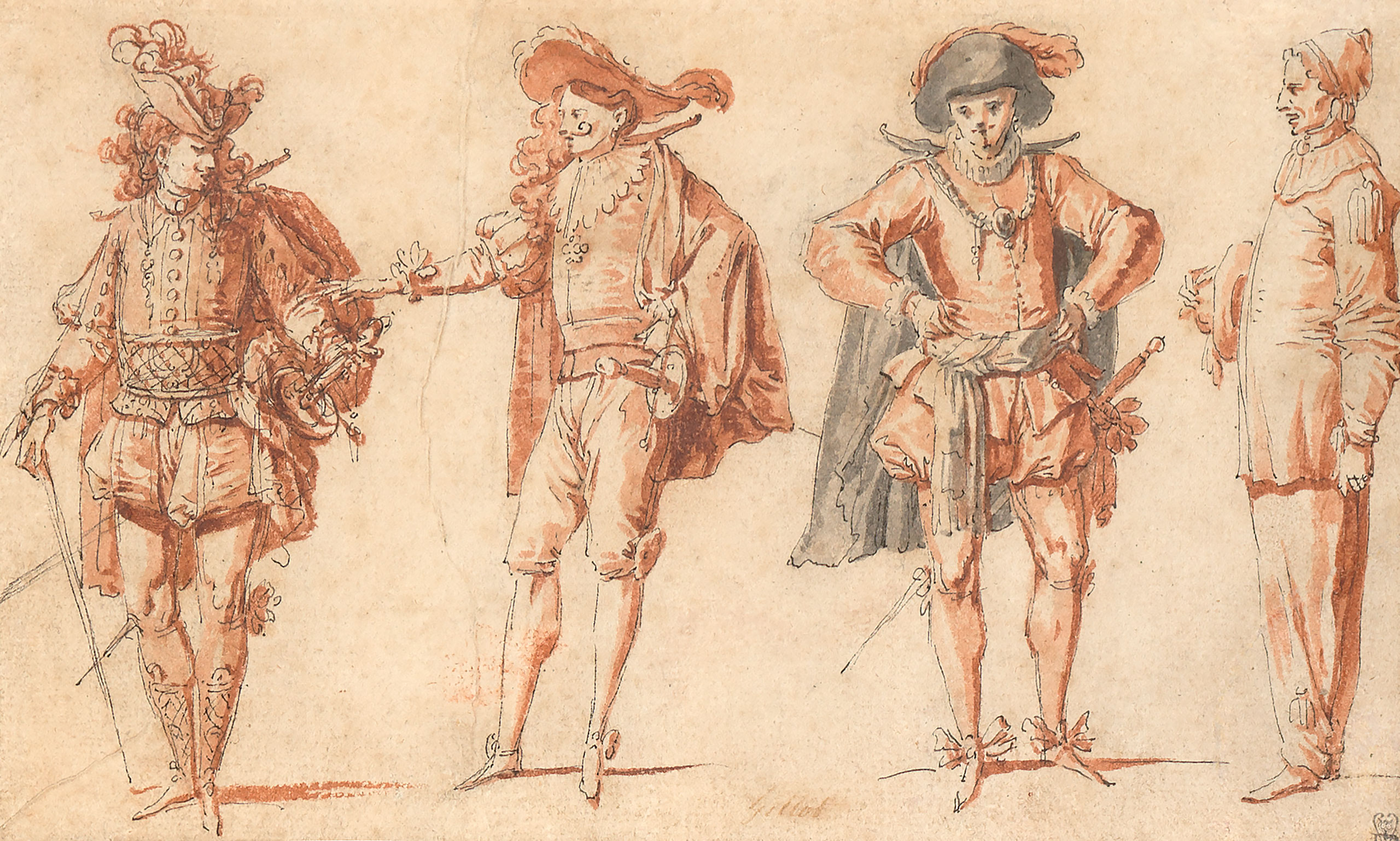
Gillot
Claude
Study of Four Figures from the Theatre
Pen and black ink, grey wash and red chalk wash.
Inscribed Gillo lower centre.
117 x 191 mm
Provenance
Leon Voillemot, Paris (Lugt 789d); Terrades Gallery, 2003; Colnaghi-Katrin Bellinger Gallery, 2007-2008; private collection.
Originally from Langres, the Gillots were related to several families of artists from their hometown including the Tassels and the Lenoirs. Claude Gillot received his first training in his father, the painter and embroiderer, Jean Gillot’s studio. In Paris circa 1691-93, he studied drawing and engraving with Jean-Baptiste Corneille, then swiftly opened his own studio that was frequented by many artists, Antoine Watteau and Nicolas Lancret among the most famous. Accredited by the Royal Academy in July 1710 with Don Quixote, in April 1717, Gillot was then received as a member on the strength of his religious painting Le Christ dans le temps qu’il va être attaché à la croix (Notre-Dame de l’Assomption). But despite this success, Gillot remained principally a draftsman and engraver and would produce only a few history paintings, most of which are now lost (for example Le Trépassement de la Vierge). Hardly any of his painted works have survived and most of those that remain are scenes from comedies; Les deux carrosses and Arlequin Le Tombeau de maître Albert1 in the Louvre and Arlequin Empereur dans la Lune that belongs to the musée des Beaux-Arts, Nantes.
In reality, Gillot would be celebrated for his creation of a new genre – that of the Italian comic scene, which would be enough, according to Émile Dacier, to ensure him “a place in the first rank amongst the fathers of our eighteenth-century art”2. Mariette too, commenting on Triomphe d’Arlequin Dieu Pan, says that, “It is one of the first paintings done in this style, and which, receiving great approval, inspired the creation of so many others that were to follow in the same genre, by Watteau etc.3” According to Mariette again, placed in charge of managing decorations, machines and costumes for the opera, Gillot produced a series of costume studies – Desseins d’habillemens à l’usage des ballets, opéras et comédies en une suite de 85 planches – that was engraved by Joullain4. So it is mainly through drawings and engravings that his art with its specific links to Italian theatre – open-air performances based on verbal expression, improvisation by stereotyped characters and bodily expression rather than text – is known to us today. In 1680, Italian actors based in France since Marie de Medici’s invitation, were installed in the Hôtel de Bourgogne. Expelled in 1697 for having mocked Madame de Maintenon, they returned under the Regency. This genre of theatre took root, however, and the scripts that were finally transcribed onto the page between 1694 and 1700 by Evaristo Gherardi – Le Théâtre italien ou Recueil de toutes les scènes françaises qui ont été jouées sur le théâtre italien de l’hôtel de Bourgogne – were abundantly picked up, reinterpreted or adapted in the Saint-Germain and Saint-Laurent fairs. Many scenarios remain unknown to us, which explains why the subjects of many of Gillot’s works are not precisely identified.
The layout of this drawing is typical of Gillot who produced a large number of these kinds of costume studies – “figures de théâtre” or “figures de caractère pour le théâtre” as they are noted in 18th-century sales. Sometimes he produced them in very similar versions of each other and reused silhouettes of certain engraved portraits of actors in their stage costumes5. The engraver François Joullain owned thirteen of these drawings “each composed of four character figures for the theatre […] in pen and coloured by Gillot. Perhaps our study also belonged to Joullain, unless it was one of the twenty-eight “theatrical figures of a fine and spiritual pen, of a piquant effect and washed for the most part in red chalk” owned by Gabriel Huquier (Sale of November 9th, 1772) or to the fifty-eight owned by a collector named Pigache (Sale of October 21st, 1776). Our sheet mixes grey wash with sanguine wash, which is quite rare.
Today several of these sheets are known and belong to various public and private collections. Some of Gillot’s drawings have been grouped together in albums, following the example of the album on the art market in 2004, published by Jennifer Tonkovitch6, which included several sheets similar to ours among other very different compositions.
- For a long time and still occasionally called Le tombeau de maître Albert due to an incorrect interpretation of the subject.
- E. Dacier, “Gillot, 1673 à 1722” in L. Dimier, Les peintres français du XVIIIe siècle, tome I, Brussels-Paris, 1928, p. 200.
- P. de Chennevières and A. de Montaiglon, Abecedario de P. J. Mariette et autres notes inédites de cet amateur sur les arts et les artistes, Paris 1853-1862, T. 2, p. 306-307.
- Idem.
- For exemple, Fabio de la comédie italienne dans son habit de médecin (engraving, Washington, National Gallery) and La Torillière le père dans son habit de valet espagnol jouant dans la comédie du Grondeur (engraving, Washington, National Gallery), both belonging to a study of Quatre acteurs de la commedia dell’arte from the Jean Bonna collection.
- Jennifer Tonkovitch, “A New Album of the Theatre Drawings by Claude Gillot” in Master Drawings, volume XLIV, n° 4/2006, p. 464-486.

